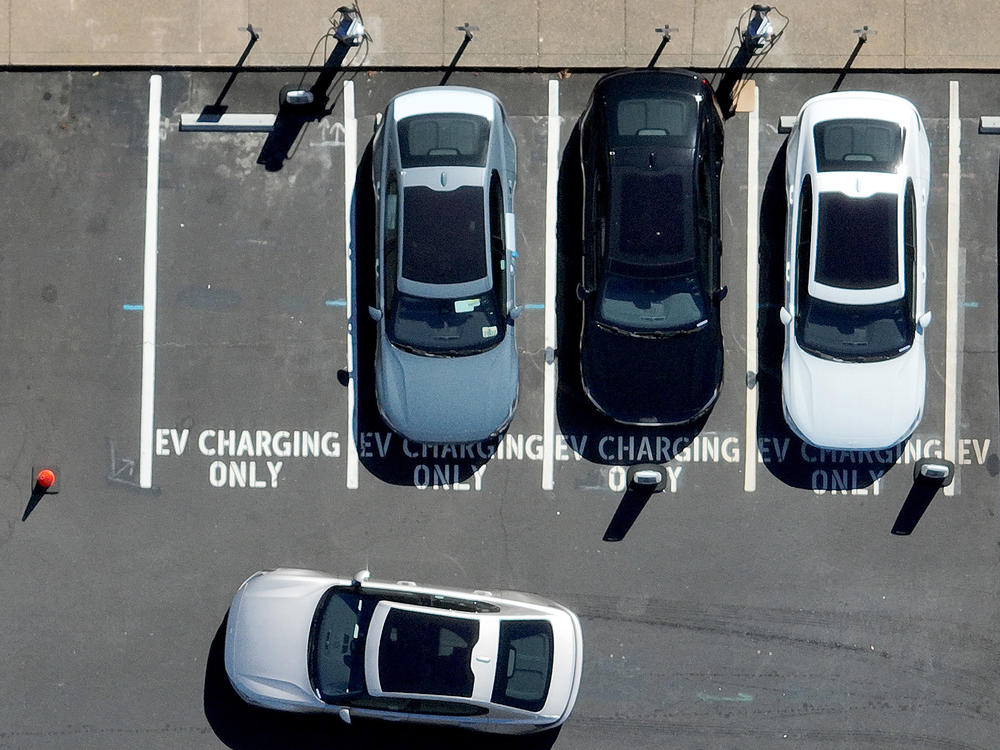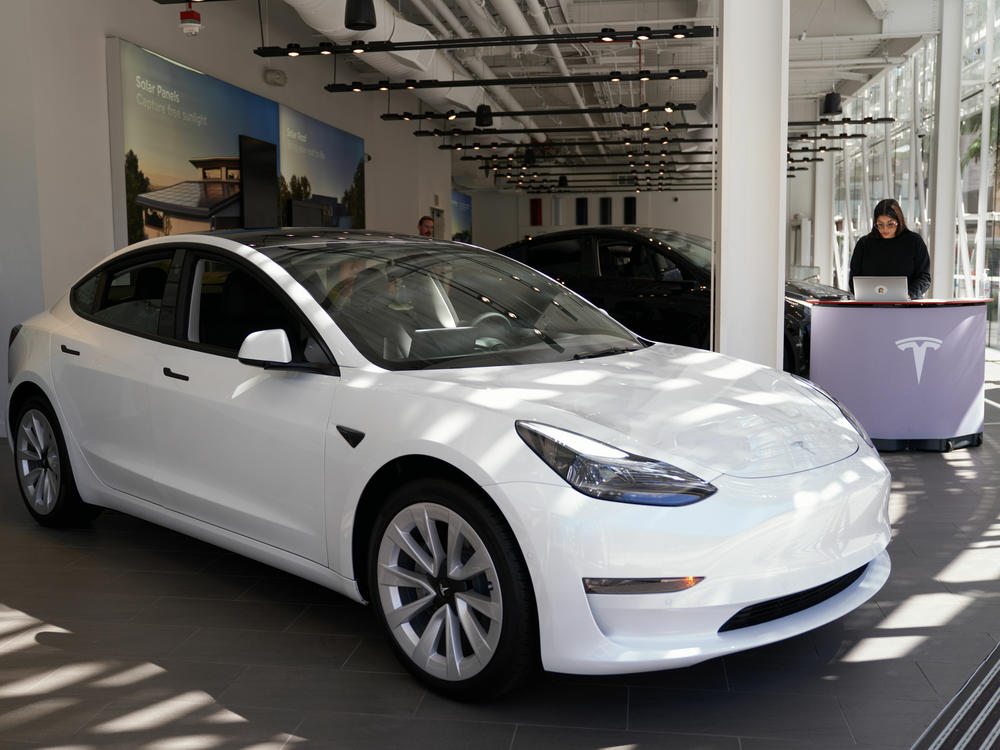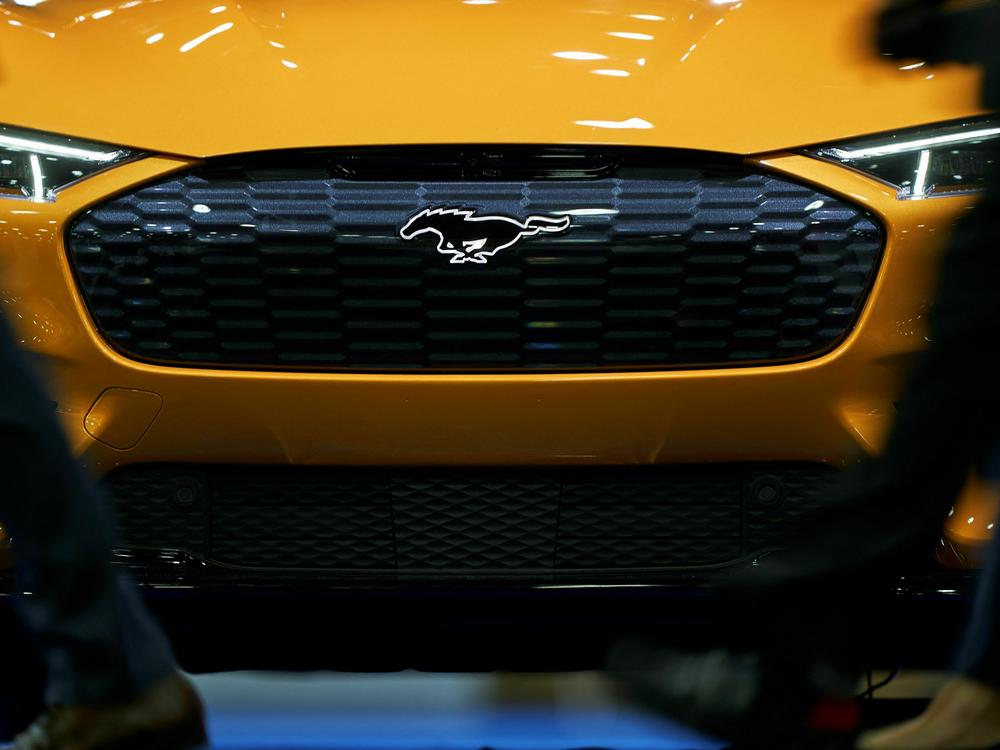Section Branding
Header Content
The $7,500 tax credit for electric cars will see big changes in 2024. What to know
Primary Content
If you are considering buying an electric car in 2024, there's good news — and bad news: A hefty federal tax credit for electric vehicles is going to get easier to access next year, but fewer vehicles will likely qualify for the full $7,500 credit.
The tax credits are a key part of the Biden administration's plan to speed up the shift to electric vehicles and slash carbon emissions from transportation.
But the government is also trying to push companies to bring more jobs to the U.S. by requiring a domestic supply chain. Those two goals can be in tension.
For car shoppers, the result can be confusing. We'll do our best to help you navigate it.
Here's a practical, plain-English guide to how the electric vehicle tax credit will work in 2024 — including why you may also consider leasing a car.
What's new for 2024: instant rebate
Starting in January, EV buyers won't have to wait until the following year's tax season to claim — and pocket — the clean vehicle tax credit.
Instead, there's a new option to take the credit as a rebate right when you purchase the vehicle. This means that after a bit of paperwork at the dealership, the credit will be available as essentially cash in hand (or, more likely, knocked off the cost of the vehicle) on the day of purchase.
It will work like this: First, after confirming the sale is eligible for the tax credit, the dealer basically fronts you the money. If you're eligible for $7,500, the dealer credits you for that money as though you'd brought it in as cash.
Then the dealer submits documentation to the IRS, and the IRS pays back the dealer that $7,500 — effectively meaning the tax credit is being handled through the dealership.
You, the buyer, still need to be under an income cap
An important part of this process is that as the buyer, you need to attest that you are under the income cap, that you're buying the vehicle for your own use and that you're buying it to use in the United States. These requirements have not changed.
That income cap is based on "modified adjusted gross income" — your income after certain deductions (like retirement contributions). It's generally Line 11 on your 1040 form, but if you have foreign income or income from Guam or Puerto Rico, you'll need to add those back in.
The income caps for new vehicles are:
- $300,000 for married couples filing jointly
- $225,000 for heads of households
- $150,000 for all other filers
Note that adjusted gross income (AGI) is not the same as total income (your salary before any deductions) or taxable income (which is AGI minus standard or itemized deductions).
"It's definitely confusing," says Alison Flores, a manager with the Tax Institute at H&R Block. "Let's say you're single. Your salary is $160,000 a year. You may say, 'Oh, I don't qualify because I'm over $150,000,'" she says.
But contributions to a 401(k), for instance, could easily mean your AGI is actually under the limit, she explains.
What if you aren't sure how much money you'll make in 2024? You can use the previous year's income to qualify — as long as you are under that cap in either 2023 or 2024, you're eligible.
And if you make more than you expected? If you told the dealer you were sure you met the income cap requirement and it turns out you were over the cap in both 2023 and 2024, then you will need to repay the IRS the $7,500 tax credit when you file your 2024 taxes. (The dealer is not involved; that's between you and the IRS to work out.)
It no longer matters how much you owe in taxes
This is another big benefit to taking the credit as a rebate: You get the full credit, regardless of your tax liability.
Previously, a buyer would need a tax liability at least $7,500 in a given year to get the full benefit of the credit. That's because the credit could reduce your tax bill to zero, but it would never result in the IRS actually paying you.
That functioned like an income minimum, since many low- and middle-income families owe less than that in taxes. It was also just another headache for people trying to figure out how much the credit was actually worth to them.
Now, even families with no tax liability at all can get the tax credit, effectively as a cash discount for the vehicle purchase.
And you don't need to calculate your taxes in advance to be confident in the amount you'll get.
Vehicles need to be made in America and under a price cap
Fully electric vehicles and plug-in hybrid vehicles can both qualify for the tax credit. To be eligible, vehicles must meet battery size and vehicle weight requirements and, more significantly, meet these two requirements:
- Be assembled in North America
- Have a sticker price (MSRP) of less than $55,000 for cars and $80,000 for SUVs and trucks
It's not always obvious which vehicles get the $55,000 cap and which get the $80,000 cap; you can confirm on fueleconomy.gov.
Features can push up the sticker price, and some vehicles are assembled in multiple locations. Dealers can verify whether those requirements are met for any individual car.
But there's more ...
Battery-sourcing requirements
The number of vehicles that qualify as of now is frequently changing. Here's why.
The $7,500 tax credit is actually two separate credits, each worth $3,750. Vehicles can qualify for both, one or neither.
To qualify, in addition to the basic criteria above, the batteries in vehicles matter. That's because the materials that go into those batteries also need to meet sourcing requirements.
These requirements are designed to encourage the auto industry to rely less on China and more on the U.S. for these components, in the name of supply chain security and U.S. jobs.
One of the $3,750 credits focuses on the raw materials inside batteries, meaning a certain percentage of critical minerals, like lithium, graphite and cobalt, need to be mined or processed in the U.S. or a trade partner.
The other $3,750 credit is about battery manufacturing: A certain percentage of the battery's components, like anodes, cathodes and electrolytes, need to be manufactured or assembled in North America.
Every year the percentages go up and the requirements get a little harder to meet. Also, starting next year, battery components can't come from companies controlled by China.
The list of qualifying cars is shifting
So which cars will qualify next year? Good question. Again, you can check fueleconomy.gov for a list of eligible vehicles, but as of late December, the site hasn't been updated for 2024.
Some changes are likely. Tesla is warning buyers that some versions of the Model 3 will see their tax credit eligibility end after Dec. 31, and Ford believes the same is true for the Mustang Mach-E.
On the other hand, Volkswagen is "cautiously optimistic" the Chattanooga, Tenn.-built ID.4 will remain eligible, and General Motors says it expects to keep the credit for "many" of its EVs. Nissan is still assessing the status of the Leaf.
Worth noting: It's when a vehicle is delivered, not when it's ordered or paid for, that affects which year's requirements apply. That means if the Mach-E does drop out of eligibility in 2024, a buyer who ordered the vehicle in December but picks it up on Jan. 1 will be out of luck.
Leasing a car could lead to far fewer restrictions
If you want to lease a vehicle, you can forget everything you just read.
Vehicles that are leased to consumers can be eligible for a version of the tax credit that is much easier to qualify for. It has no requirement that vehicles be made in America, no price cap for vehicles and no income caps. So if you want to lease a Kia EV6 from South Korea or a six-figure luxury sedan? Go to town.
The credit goes to the company leasing out the vehicle — not the person driving it — and companies aren't required to pass the savings on to consumers.
But companies typically do pass along the discount in the form of a bonus applied at the start of the lease.
Of course, with a lease you have caps on mileage per year, and you're not paying off a vehicle that you'll eventually own free and clear. Be sure to consider whether a lease meets your needs. Make sure the discount is actually passed along to you, and read your entire contract carefully.
EV leases have increased dramatically since April 2023, when many vehicles became ineligible for the purchase tax credit as the battery-sourcing restrictions kicked in.
Don't forget: There is also a credit for buying a used EV
Do the prices for new electric vehicles make you feel faint?
Well, if they do, consider used ones. That's because if you buy a used electric vehicle — for 2024, from model year 2022 or earlier — there's a tax credit for you too. It's worth 30% of the sales price, up to $4,000.
This tax credit has a much lower income cap: $150,000 for a household, $75,000 for a single person. Again, that's adjusted gross income, meaning an individual's salary may be higher than that and the person could still qualify.
There's a lower price cap too: Vehicles must cost less than $25,000.
Used-EV prices have been falling rapidly lately, so while availability is still pretty tight, a qualifying vehicle is easier to find now than it used to be.
A couple of other requirements: This needs to be the first time the car was sold as a used vehicle since mid-2022. (That way, the IRS knows the used-vehicle credit gets applied only once.) You also have to buy the used vehicle from a dealership, not from an individual, and that dealership has to be registered with the IRS to be able to report the sale.
Some buyers may be getting creative to meet that last requirement. The app Caramel, which is designed to facilitate private-party vehicle sales, is technically a licensed dealership. The company reports that EVs, and specifically used EVs potentially eligible for the tax credit, make up a surprisingly high percentage of transactions.
Caramel says it plans to offer the tax credit for 2024 as an upfront discount, just like a brick-and-mortar dealership would.
Finally, you can get a very hefty credit for a business vehicle
If you run a business, you may be interested in the separate commercial tax credit for EVs, which provides up to $7,500 for a light vehicle and up to $40,000 for a larger vehicle, like a delivery truck.
There are far fewer restrictions on the commercial tax credit, in terms of price cap or sourcing requirements. Of course, the vehicle does have to be used for a business purpose.
The amount of the credit depends on the purchase price of the vehicle: More details are here.
And note that for a single vehicle you can get either the clean vehicle tax credit or the commercial vehicle tax credit, but not both.
Copyright 2023 NPR. To see more, visit https://www.npr.org.



